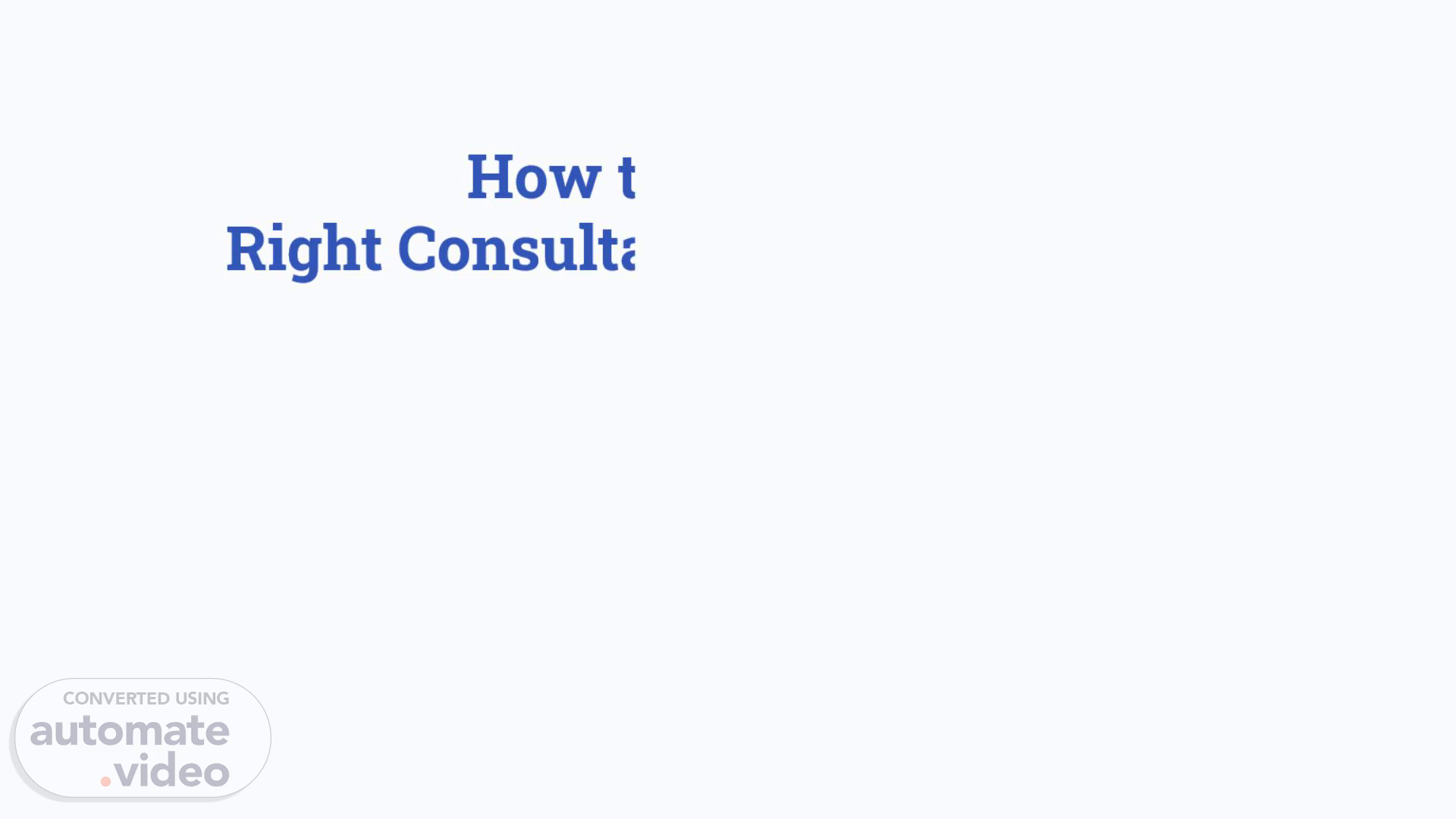Scene 1 (0s)
How to Choose the Right Consultant for Your Business.
Scene 2 (11s)
[Audio] Before we begin, type one word in the chat that comes to mind when you hear the word consultant..
Scene 3 (19s)
[Audio] By the end of this session, you'll be able to: make informed decisions when hiring consultants, clearly define your business problems before seeking support, understand the difference between a consultant and an employee, write simple Terms of Reference, ask the right interview questions and spot red flags, and manage conflict constructively. We'll also share practical tools and templates..
Scene 4 (46s)
[Audio] Have you ever struggled to find the right consultant? You're not alone. Many SMEs face this challenge..
Scene 5 (54s)
[Audio] Hiring the wrong consultant doesn't just waste money. It erodes trust, drains time, and slows your business momentum. That's why getting it right is so important..
Scene 6 (1m 24s)
[Audio] Let's clarify the difference between a consultant and an employee. Consultants are short-term, result-based, and independent. Employees are long-term, process-driven, and part of your team culture. Knowing when to hire which is key..
Scene 7 (2m 2s)
[Audio] Use a consultant when you need specialized expertise, a time-bound project, or an external perspective. Hire an employee when the role is ongoing, requires full-time oversight, or is part of your long-term growth..
Scene 8 (2m 23s)
[Audio] The first step is to clearly define your business need. Ask: What problem are we solving? What does success look like? And is this a one-off project or ongoing support? Take a moment — if you can, type your challenge in one sentence into the chat..
Scene 9 (2m 40s)
[Audio] A Terms of Reference, or ToR, sets clear expectations. It outlines background, objectives, scope of work, deliverables, timelines, qualifications, and evaluation criteria. This document protects both you and the consultant by establishing accountability from the start..
Scene 10 (3m 4s)
[Audio] Let's look at a sample ToR. It begins with the background: here you describe your business and the challenge you want solved. Next is the objective of the assignment: what exactly you want the consultant to achieve — for example, developing a business plan or identifying new partners. Then comes the scope of work: the specific activities the consultant will carry out, such as reviewing sales processes, conducting strategy sessions, or drafting a plan. After that, you'll list the deliverables and timelines: for instance, a workplan in week one, strategy sessions in weeks two and three, and a final report in week four. The ToR also specifies reporting and coordination: who the consultant reports to, and how often you'll check in. Then you outline the required qualifications: experience, skills, or sector knowledge needed. Finally, the evaluation criteria: how you will score proposals — such as experience, understanding of the assignment, methodology, and cost. This structure ensures you get clear, comparable proposals and helps consultants know exactly what's expected. We'll share an editable template so you can adapt it to your business..
Scene 11 (4m 21s)
[Audio] When interviewing, ask core questions like: Have you done this before? What approach will you use? What risks do you anticipate? Also, pay attention to soft skills. Are they good listeners? Do they explain ideas clearly? Do they take ownership? These cues matter just as much as technical expertise..
Scene 12 (4m 45s)
[Audio] Be cautious of vague proposals, evasive answers, consultants who resist contracts, or poor communicators. And remember — trust your instincts..
Scene 13 (5m 6s)
[Audio] Conflict can happen if expectations are unclear, the scope changes, or communication breaks down. Early warning signs include vague deliverables, defensive behavior, or loss of engagement. Prevent this by setting clear ToRs, holding regular check-ins, and documenting agreements..
Scene 14 (5m 51s)
[Audio] If conflict arises, address it early and constructively. Refer back to the ToR, involve a neutral third party if needed, and always keep communication open. Unresolved conflict can lead to project collapse, financial loss, and damaged relationships..
Scene 15 (6m 11s)
[Audio] To recap: Begin with a well-defined need. Use structured ToRs. Interview with purpose and watch for red flags. Manage the relationship proactively. These steps will help you choose the right consultant and set your business up for success."What's one thing you'd do differently next time to avoid conflict with a consultant? Please type it in the chat..
Scene 16 (6m 35s)
[Audio] Here is the Consult Afrika platform. It's a digital space where businesses and organizations can connect with vetted consultants across Africa. It is built to simplify access to expert advice, business growth solutions, and learning resources , In short, this is the bridge between African businesses that need guidance, and the skilled professionals who can provide it.".
Scene 17 (7m 0s)
[Audio] At Consult Afrika, we connect businesses and organizations with vetted consultants across Africa. Our mission is to empower SMEs, entrepreneurs, and NGOs by making expert advisory and tailored solutions easy to access. In short, this is the bridge between African businesses that need guidance, and the skilled professionals who can provide it.".
Scene 18 (7m 27s)
[Audio] We exist because too many businesses struggle to find the right expertise. Whether it's strategy, finance, or digital transformation, we bridge the gap by matching you with qualified consultants and providing tools to manage those relationships effectively..
Scene 19 (8m 0s)
[Audio] Let's choose the right consultant to take your business to the next level. Please share your questions or reflections in the chat..
